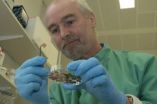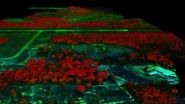Fox invasion threatens wave of extinction, UC research finds
2012-12-04
(Press-News.org) Using DNA detection techniques developed at the University, the team mapped the presence of foxes in Tasmania, predicted their spread and developed a model of their likely distribution as a blueprint for fox eradication, but swift and decisive action is needed.
University of Canberra professor in wildlife genetics and leader of the team, Stephen Sarre, found foxes are widespread in northern and eastern Tasmania and the model developed by his team forecasts they will spread even further with likely devastating consequences for the island's wildlife.
"There's nothing fantastic about foxes being in Tasmania. If we allow them to establish themselves we could see a catastrophic wave of extinction across the island," Professor Sarre said.
"This research shows foxes are on the verge of becoming irreversibly present in Tasmania," he said. "Their apparent widespread distribution indicates that the eradication effort is at a critical point and that there is no time to lose."
Professor Sarre and colleagues used forensic DNA tests combined with collections of fox scats to detect and map the distribution of the predator in Tasmania.
Their detective work, in partnership with Tasmania's Fox Eradication Program, represents one of the largest surveys of its kind worldwide and provides the first systematic examination of the distribution of foxes in the island, following evidence and allegations that indicate a long history of isolated introductions.
According to Professor Sarre, the widespread nature of the predator distribution in Tasmania reveals that targeting only fox activity hotspots for eradication is unlikely to be successful.
"The recently adopted plan of baiting all highly suitable fox habitats is the right one given the widespread fox distribution that we've found.
"The present situation could be as serious a threat to the pristine Tasmanian environment as the previous extinction wave was to Australia's mainland fauna, following the arrival of Europeans and which has so far wiped out more than 20 species.
"We suggest an increased effort and an even more focused approach to maximize the chances of a successful eradication. Otherwise, Australia stands on the precipice of another major episode of mammalian extinctions."
INFORMATION:
The organisations involved in the research include the University of Canberra, Arthur Rylah Institute, NSW Department of Primary Industry, and Tasmanian Department of Primary Industry Parks Water and the Environment collaborating, with and partially funded by, the Invasive Animals CRC.
ELSE PRESS RELEASES FROM THIS DATE:
2012-12-04
After years of basic research, scientists at Johannes Gutenberg University Mainz (JGU) are increasingly able to understand the mechanisms underlying the human Usher syndrome and are coming ever closer to finding a successful treatment approach. The scientists in the Usher research group of Professor Dr. Uwe Wolfrum are evaluating two different strategies. These involve either the repair of mutated genes or the deactivation of the genetic defects using agents. Based on results obtained to date, both options seem promising. Usher syndrome is a congenital disorder that causes ...
2012-12-04
New research from the University of Southampton has shown that copper can prevent horizontal transmission of genes, which has contributed to the increasing number of antibiotic-resistant infections worldwide.
Horizontal gene transfer (HGT) in bacteria is largely responsible for the development of antibiotic-resistance, which has led to an increasing number of difficult-to-treat healthcare-associated infections (HCAIs).
The newly-published paper, which appears in the journal mBio, shows that while HGT can take place in the environment, on frequently-touched surfaces, ...
2012-12-04
One of the big challenges of biomedicine is understanding the origin of illnesses in order to improve early detection and significantly increase recovery rates, as well as being able to do what CNIO researchers call preventive molecular medicine, which consists of identifying those individuals who have a greater molecular risk of suffering certain pathologies in order to prevent them. The ageing of the organism, and therefore of the cells and tissues it is made of, represents the greatest risk factor for the majority of developed-world illnesses, including cancer.
A team ...
2012-12-04
San Francisco, CA —Researchers from the Carnegie Institution are rolling out results from the new Airborne Taxonomic Mapping System, or AToMS, for the first time at the American Geophysical Union (AGU) meetings in San Francisco. The groundbreaking technology and its scientific observations are uncovering a previously invisible ecological world. To watch a video about how AToMS is helping researchers look at the world in a whole new way, click here.
AToMS, which launched in June 2011, uniquely combines laser and spectral imaging instrumentation onboard a twin-engine aircraft ...
2012-12-04
DURHAM, NC -- About 75 percent of Africa's savannahs and more than two-thirds of the lion population once estimated to live there have disappeared in the last 50 years, according to a study published this week in the journal Biodiversity and Conservation.
The study, led by Duke University researchers, estimates the number of lions now living on the savannahs to be as low as 32,000, down from nearly 100,000 in 1960. Lion populations in West Africa have experienced the greatest declines.
"The word savannah conjures up visions of vast open plains teeming with wildlife. ...
2012-12-04
How do driverless vehicles navigate through intersections? Faster and safer than if humans were in charge, according to researchers with the Virginia Tech Transportation Institute.
Autonomous vehicles will turn themselves over to an automated intersection controller, which adjusts the trajectory and speed of the vehicles to prevent crashes, said Ismail Zohdy of Cairo, Egypt, a Ph.D. student in civil engineering at Virginia Tech, and Hesham Rakha, director of the Center for Sustainable Mobility at the transportation institute and professor of civil engineering at the university. ...
2012-12-04
New Rochelle, NY, December 4, 2012—Human mesenchymal stem cells (hMSCs) can develop into bone cells and are useful for tissue engineering and regeneration. However, when grown in the laboratory they quickly lose their ability to continue dividing and they die. A method for genetically engineering hMSCs so they become immortal and still retain their ability to become bone cells is described in an article published in BioResearch Open Access, a bimonthly peer-reviewed journal from Mary Ann Liebert, Inc., publishers. The article is available free on the BioResearch Open Access ...
2012-12-04
Wilmington, DE – This month, Molecular Pharmaceutics reported promising findings from the Nemours Center for Childhood Cancer Research and the Materials Science and Engineering Department at the University of Delaware, about the potential for nanotechnology to deliver chemotherapeutic agents in a way that attacks cancer cells without harming healthy cells. To date, nanoparticle-based drug delivery approaches have been poorly developed for the treatment of childhood leukemia, which comprises 30% of childhood cancers. In the Nemours study, encapsulated dexamethasone ("dex") ...
2012-12-04
MANHATTAN, Kan. -- A new study may help scientists produce better climate-resistant corn and other food production plants by putting a spin on the notion that we are what we eat.
Kansas State University geneticists and colleagues found that by applying a genetic-analysis method used to study and prioritize the genes in humans, it improved the likelihood of finding critical genes in food production plants. These genes control quantitate traits in plants, such as how the plants grow and when they flower.
Additionally, this method can be used to study how food production ...
2012-12-04
Boston – Jonathan Welch, MD, a physician in the Department of Emergency Medicine at Brigham and Women's Hospital, never thought his family would be part of a medical error. But when his mother's battle with cancer took a sudden turn and she was rushed to a community hospital in Wisconsin, Welch watched in helpless horror as a series of mistakes lead to her death. After the funeral, he encouraged the Wisconsin hospital's administrators to make changes to avoid future errors and deaths, but his experience proved frustrating and fruitless. Now, in an essay that appears ...
LAST 30 PRESS RELEASES:
[Press-News.org] Fox invasion threatens wave of extinction, UC research finds


